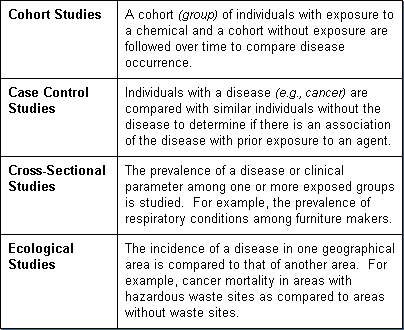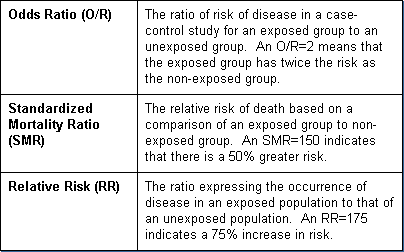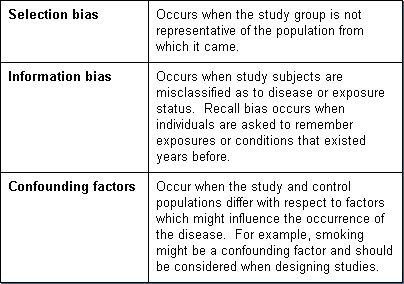|
 |
 |
 |
 |
|
|
|







Epidemiology studies are conducted using human populations to evaluate whether there is a causal relationship between exposure to a substance and adverse health effects.
These studies differ from clinical investigations in that individuals have already been administered the drug during medical treatment or have been exposed to it in the workplace or environment.
Epidemiological studies measure the risk of illness or death in an exposed population compared to that risk in an identical (e.g., same age, sex, race, social status, etc.), unexposed population.
There are four primary types of
epidemiology studies. They are:

Cohort studies are the most commonly conducted
epidemiology studies. They frequently involve occupational exposures. Exposed persons are easy to identify and the exposure levels are usually higher than in the general public. There are two types of cohort studies:

To determine if epidemiological data are meaningful, standard, quantitative measures of effect are employed. The most commonly used are:

There are a number of aspects in designing an
epidemiology study. The most critical are appropriate controls, adequate time span, and statistical ability to detect an effect.
The control population used as a comparison group must be as similar as possible to that of the test group, e.g., same age, sex, race, social status, geographical area, and environmental and lifestyle influences.
Many epidemiology studies evaluate the potential for an agent to cause cancer. Since most cancers require long latency periods, e.g., 20 years, the study must cover that period of time.
The statistical ability to detect an effect is referred to as the power of the study. To gain precision, the study and control populations should be as large as possible.
Epidemiologists attempt to control errors that may occur in the collection of data. These errors, known as bias errors, are of three main types:


  
|
|
|
|